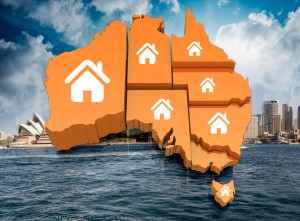CoreLogic’s national Home Value Index surged 1.7% higher over the month and delivered the fifth consecutive monthly increase, coupled with the largest monthly gain in the national index since 2003. 
Since finding its trough in June earlier this year, the national dwelling value index has recovered by 4.7%.
Although values are recovering rapidly, at a national level home values remain 4.1% below their 2017 peak, tracking roughly at the same level as recorded in the January 2017 index results.
Sydney and Melbourne continued to drive the rapid recovery, with values up by 2.7% and 2.2% respectively over the month.
All remaining capital cities, excluding Darwin, demonstrated a broadening in the geographic scope of this upswing with values rising over the month.

In a significant turn of events for the Perth market, values edged 0.4% higher in November; the first month-on-month rise in dwelling values since the downtrend took a pause in early 2018.
Dwelling values have been trending lower since mid-2014, down a cumulative 21.3% through to the end of November.
Over the past thirteen years, Perth has seen house values move from being the most expensive across the capital cities to now be the lowest; great news for first home buyers, however Perth home owners have seen a material reduction in their wealth over the past five and a half years.

The November results have seen CoreLogic’s national index nudge back into positive annual growth territory for the first time since April 2018, with dwelling values 0.1% higher over the past twelve months.
Four of Australia’s capital cities moved back into positive annual growth, led by Hobart (+4.2%), Canberra (+3.0%), Melbourne (+2.2%) and Sydney (+1.6%), while the largest declines remain in Darwin (-10.9%) and Perth (-7.7%).
A variety of factors are supporting the strong gains in housing values.
The synergy of a 75 basis points rate cut from the Reserve Bank, a loosening in loan serviceability policy from APRA, and the removal of uncertainty around taxation reform following the federal election outcome, are central to this recovery.

Additionally, we’re seeing advertised stock levels persistently low, creating a sense of urgency in the market as buyer demand picks up.
There’s also the prospect that interest rates are likely to fall further over the coming months and an improvement in housing affordability following the recent downturn are other factors supporting a lift in values.
Housing values are generally rising across the regional areas of Australia, but the recovery trend is milder relative to the capital cities.
CoreLogic’s combined capital cities index is 4.6% higher over the past three months with values recovering by 5.7% since bottoming out in June.
The combined regionals index is up a smaller 1.1% over the past three months and values have recovered only 1.1% since finding a floor in August. Across the broader regional areas of the states, Tasmania is seeing the strongest growth with values up 2.2% over the past three months, followed by Queensland (+1.8%), New South Wales (+1.2%) and Victoria (+1.0%).
Although housing values are rising across each of the valuation cohorts, the recovery trend is most concentrated within the premium sector of the market.
This trend is most evident in Sydney and Melbourne where the top quartile of the market is outperforming the broad ‘middle’ of the market and lower quartile.
Values across Sydney’s top quartile were up 7.4% over the three months ending November, compared with a 3.8% rise across the lower quartile.
Similarly, in Melbourne, top quartile values were up 8.1% over the same three month period compared with a 4.2% rise across the lower quartile.
Brisbane, Perth and Darwin are also recording a similar trend where premium value properties are outperforming lower value properties.
The stronger performance across the higher value end of the market can likely be attributed to a combination of values falling more in this sector during the downturn, as well as recent adjustments to serviceability rules which has boosted borrowing capacity.


Additionally, the scarcity value of detached homes in many of the blue-chip property markets is another factor supporting strong capital gains.
As housing values become less affordable in these high-end markets, demand is likely to ripple outwards to the more affordable areas.
Over the past twelve months, twenty-two of the forty-six capital city sub-regions have recorded a decline in dwelling values. 
The strongest sub-regions for growth across the capital cities are now in areas of Melbourne and Sydney’s prestige market.
Melbourne’s Inner East, where the median dwelling value is $1.18 million, has surged back to positive annual growth, up 8.0% over the past twelve months.
The rapid bounce back follows a significant decline in values across the region, where values fell 18.0% from peak to trough.
The largest declines are generally confined to areas of Perth and Darwin, which comprise eight of the ten largest dwelling value declines over the past year.
The past three months has seen only six of the forty-six capital city sub-regions record a fall in home values, comprised of areas across Perth as well as Darwin.
Perth’s Inner SA4 sub-region, which is also the most expensive sub-region of Perth, was the only area of Perth to record a rise in values over the past three months.
The best performing capital city sub-regions over the past three months were located in Sydney and Melbourne, with Sydney’s Ryde (+9.3%) and Melbourne’s Inner East (+9.0%) recording the highest capital gains.
Across the forty-two regional areas of Australia, seventeen have recorded a rise in values over the past twelve months.
Regional Tasmania continues to show the best capital gains, at least on an annual basis, with values across the West/North West SA4 region up almost 6% over the past twelve months and values across the South East region 5.3% higher. 
The weakest regional markets continued to be the broader outback regions of Queensland and South Australia, as well as many of the agricultural regions around the country which continue to be adversely affected by drought.
More recently, the past three months has seen more than half of the regional SA4 areas return an increase in dwelling values.
Twenty-five of the forty-two regional areas recorded a rise over the three months ending November.
The cities surrounding Sydney and Melbourne, including Illawarra (+4.2%), Newcastle & Lake Macquarie (+2.8%), Bendigo (+1.0%), Geelong (+1.0%) and Ballarat (+0.5%) are now trending higher.
Eastern Seaboard lifestyle markets are also lifting, with areas like Sunshine Coast (+2.7%), Gold Coast (+2.2%), Cairns (+2.7%), Richmond- Tweed (+0.7%) and Wide Bay (+0.7%) all reporting higher home values over the rolling quarter.

Rental markets are continuing to show a sluggish performance, with rents unchanged over the month across the combined capitals and rising 0.2% over the month across the combined regional areas of Australia.
Rents continued to trend lower in Sydney (-0.1% in November) and were also down slightly in Hobart (-0.6%) and Darwin (-0.5%).
The remaining capital cities are generally seeing weak rental market conditions. 
On an annual basis, the largest rental increases are in Hobart (+5.8%) and Perth (+2.3%), with rents down 1.5% in Sydney and 2.5% lower in Darwin over the year.
Softer rental conditions can be attributed to a range of factors including the recent history of rising rental supply, demonstrated by unprecedented levels of investment participation in the housing market between 2012 and 2017, as well as a significant increase in dwelling construction skewed towards rental accommodation in the high rise apartment sector.
Additionally, a larger than normal number of renters have transitioned to first home buyers, thereby denting rental demand.
As dwelling values trend higher and rental growth remains low, gross rental yields are starting to compress.
Across the combined capitals, gross rental yields moved through a recent peak in May earlier this year at 3.88%.
Since that time, gross rental yields across the combined capitals have reduced back to 3.56% which is the lowest gross yield since July last year.
Although gross rental yields are trending lower, so too are mortgage rates. 
At the end of October, the average three-year fixed rate for an investor mortgage was 3.48%.
This is now lower than capital city gross rental yields for the first time since at least 2007 (when CoreLogic’s rental yield series commences), implying that more properties will be showing a positive cash flow for investors, and paying off a mortgage may be more affordable than paying rent in many areas.
The Australian housing market is now five months into an unexpected period of rapid recovery.
The question is, how long can such a high pace of capital gains be sustained?
Annualising the growth rate over the past three months implies the national index is already tracking well above double digit annual growth (+15.3%), while Sydney and Melbourne dwellings are tracking around the mid-twenty percent range for annualised capital gains based on the most recent three month trend.
Considering wages and household income growth remains low, economic conditions are losing momentum and housing affordability is once again worsening (from an already high base in the largest cities), there are likely to be some headwinds in maintaining such a fast recovery.
Additionally, the market is yet to be tested on higher supply levels.
Advertised listing numbers have remained seasonally low throughout spring due to low new listing numbers and an increased rate of absorption as buyer demand lifts.
With selling conditions looking very strong, there is a high probability that listing numbers will show a material lift through the first quarter of 2020 which will test the depth of the market, and likely ease some of the urgency that is contributing to higher prices.
Smaller cities are starting to show a stronger growth trajectory in the housing market, including Perth, where housing values have been trending lower since mid-2014.
As housing affordability becomes more pressing, jobs growth fades and unemployment ticks higher across New South Wales and Victoria, the smaller capital cities may be beneficiaries of increased demand.

Based on data to June from the Australian Bureau of Statistics, there is a clear trend towards stronger interstate migration rates into Queensland as well as a reduction in the interstate outflow from South Australia and Western Australia. 
More affordable housing options across the smaller cities is likely to be attractive to interstate residents, however jobs growth and the employment rate is generally weaker relative to the larger cities which remains a barrier to higher housing demand.
With interest rates likely to track lower in 2020, we could see additional stimulus counteracting some of these headwinds.
Mortgage rates are already at their lowest level since at least the 1950’s which is one of main factors supporting increasing market activity.
If rates do move lower, no doubt policy makers will be watchful for any triggers that could provoke a policy response limiting housing credit. Previous rounds of macro-prudential have had an immediate slowing effect on market activity.
from Property UpdateProperty Update https://propertyupdate.com.au/housing-rebound-continues-to-spread/


No comments:
Post a Comment